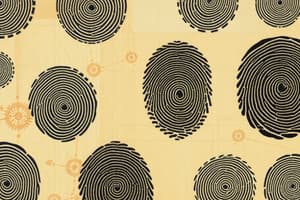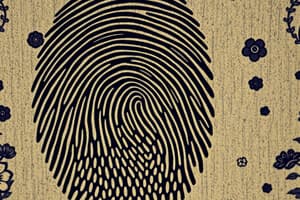Podcast
Questions and Answers
What type of fingerprint pattern represents the majority of the population?
What type of fingerprint pattern represents the majority of the population?
- Whirl
- Delta
- Arch
- Loop (correct)
Which fingerprint pattern is characterized by no deltas?
Which fingerprint pattern is characterized by no deltas?
- Radical
- Arch (correct)
- Whirl
- Loop
What is a key feature of level one fingerprint comparison?
What is a key feature of level one fingerprint comparison?
- Chemical residue detection
- Classification into basic patterns (correct)
- Detailed minutiae analysis
- Identifying visible prints only
What can cause fingerprints to become more identifiable after recording?
What can cause fingerprints to become more identifiable after recording?
Which type of print is created in a soft pliable substance and can be left behind as an impression?
Which type of print is created in a soft pliable substance and can be left behind as an impression?
Which layer of skin contains blood vessels and receptor cells?
Which layer of skin contains blood vessels and receptor cells?
What main components are found in the epidermis?
What main components are found in the epidermis?
How do the patterns formed by ridges and furrows in fingerprints change throughout life?
How do the patterns formed by ridges and furrows in fingerprints change throughout life?
Which part of the integumentary system is considered the largest organ system in the human body?
Which part of the integumentary system is considered the largest organ system in the human body?
Which layer of skin is responsible for containing fat and larger blood vessels?
Which layer of skin is responsible for containing fat and larger blood vessels?
What distinguishes synthetic fibers from natural fibers?
What distinguishes synthetic fibers from natural fibers?
Which of the following is an example of a regenerated fiber?
Which of the following is an example of a regenerated fiber?
Which of the following animal sources is NOT typically used for fibers?
Which of the following animal sources is NOT typically used for fibers?
What happens to synthetic fibers when exposed to heat?
What happens to synthetic fibers when exposed to heat?
What forensic question helps determine whether fibers are natural or synthetic?
What forensic question helps determine whether fibers are natural or synthetic?
Which technique uses a fine powder to reveal latent fingerprints?
Which technique uses a fine powder to reveal latent fingerprints?
What color does Ninhydrin produce when it reacts with amino acids?
What color does Ninhydrin produce when it reacts with amino acids?
What is the purpose of lifting prints with cellophane tape?
What is the purpose of lifting prints with cellophane tape?
Which layer of hair is responsible for providing structure?
Which layer of hair is responsible for providing structure?
What type of cross-section does Asian hair typically have?
What type of cross-section does Asian hair typically have?
What is the primary protein found in hair?
What is the primary protein found in hair?
Which hair pattern is described as shingle-shaped?
Which hair pattern is described as shingle-shaped?
What is the main function of melanin in hair?
What is the main function of melanin in hair?
What type of evidence is represented by fibers?
What type of evidence is represented by fibers?
What is the inner layer of hair called?
What is the inner layer of hair called?
Flashcards
Epidermis
Epidermis
The outer layer of skin, consisting of multiple layers of cells. It's thicker on the palms and feet and contains melanin, fingerprints, and other unique patterns.
Dermis
Dermis
The middle layer of skin, responsible for hair follicles, sweat glands, and blood vessels.
Hypodermis
Hypodermis
The innermost layer of skin, containing fat and connective tissue.
Fingerprints
Fingerprints
Signup and view all the flashcards
Fingerprint permanence
Fingerprint permanence
Signup and view all the flashcards
Loop Fingerprint Pattern
Loop Fingerprint Pattern
Signup and view all the flashcards
Arch Fingerprint Pattern
Arch Fingerprint Pattern
Signup and view all the flashcards
Level Three Fingerprint Comparison
Level Three Fingerprint Comparison
Signup and view all the flashcards
Patent Fingerprint
Patent Fingerprint
Signup and view all the flashcards
Plastic Fingerprint
Plastic Fingerprint
Signup and view all the flashcards
Wool
Wool
Signup and view all the flashcards
Regenerated Fibers
Regenerated Fibers
Signup and view all the flashcards
Synthetic Fibers
Synthetic Fibers
Signup and view all the flashcards
Elastomers
Elastomers
Signup and view all the flashcards
Fiber Analysis
Fiber Analysis
Signup and view all the flashcards
Dusting for prints
Dusting for prints
Signup and view all the flashcards
Ninhydrin
Ninhydrin
Signup and view all the flashcards
Iodine
Iodine
Signup and view all the flashcards
Cyanoacrylate (superglue) fuming
Cyanoacrylate (superglue) fuming
Signup and view all the flashcards
Lifting prints
Lifting prints
Signup and view all the flashcards
Pinnascopy
Pinnascopy
Signup and view all the flashcards
Cheiloscopy
Cheiloscopy
Signup and view all the flashcards
Cuticle (hair)
Cuticle (hair)
Signup and view all the flashcards
Cortex (hair)
Cortex (hair)
Signup and view all the flashcards
Medulla (hair)
Medulla (hair)
Signup and view all the flashcards
Study Notes
Fingerprints
- Fingerprints are ridges and furrows on the skin.
- These patterns are formed by ridges and furrows.
- These patterns do not change throughout a person's lifetime, except in cases of significant skin trauma
- Skin is a part of the integumentary system.
- The integumentary system includes skin, hair, and nails.
- Skin is the largest organ system in the human body, weighing 25 pounds.
- Skin has three layers: epidermis, dermis, and hypodermis.
- Epidermis is the outermost layer. Its layers include stratum corneum, which is 25 to 30 cell layers thick in palms and feet. It also contains melanin, fingerprints, palm prints, and more.
- Dermis is the middle layer consisting of protein that contains hair follicles, oil glands, sweat glands and blood vessels.
- Hypodermis or subcutaneous layer is the bottom layer which contains fat and connective tissues with larger blood vessels and nerves.
Fingerprint Patterns
- Common fingerprint patterns: arch, loop, and whorl.
- Arch patterns: make up 5% of the population, have no deltas.
- Loop patterns: make up about 65% of the population, have one delta and one core.
- Whorl patterns: make up 10% of the population, have two deltas.
Fingerprint Identification Methods
- IAFIS (Integrated Automated Fingerprint Identification System) - a classification system that is still commonly used today for identifying fingerprints.
- Henry fingerprint classification system is a system of identifying fingerprints.
- Level 1, 2, and 3 classification details for matching.
- Level 1: general patterns (arch, loop, whorl)
- Level 2: minutiae details (ridge endings, bifurcations).
- Level 3: pores, ridge shape, and details.
Fingerprint Comparison
- Loops, whorls, and arches are the main features used in comparisons.
- Loops have one delta and one core.
- Whorls have two deltas.
- Arches have no deltas.
Fingerprint Visualization
- Techniques to visualize fingerprints include dusting with powders, using ninhydrin to react with amino acids, and using iodine.
- Powders can be colored, magnetic, or fluorescent
- Ninhydrin: reacts with amino acids to form a purplish blue image
- Iodine: reacts with oils forming a brown image
- Cyanoacrylate (superglue) is used in a fuming chamber to react with amino acids forming a white image.
Preserving Fingerprints
- Cellophane tape is used to lift prints from surfaces to be stored.
- Photocopies and digital images are taken of prints for further studies.
Studying That Suits You
Use AI to generate personalized quizzes and flashcards to suit your learning preferences.
Related Documents
Description
This quiz covers key concepts related to fingerprints and the integumentary system. You'll explore the structure of skin, its layers, and the permanence of fingerprint patterns. Test your knowledge on different types of fingerprint patterns and the functions of each skin layer.




